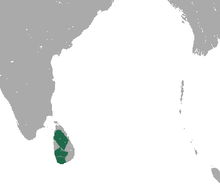Whitebeard langur
| Whitebeard langur | ||||||||||||
|---|---|---|---|---|---|---|---|---|---|---|---|---|

White whiskered langur ( Semnopithecus vetulus ) |
||||||||||||
| Systematics | ||||||||||||
|
||||||||||||
| Scientific name | ||||||||||||
| Semnopithecus vetulus | ||||||||||||
| ( Erxleben , 1777) |
The purple-faced langur ( semnopithecus vetulus ) is a primate art from the group of Slim monkeys is one of the two species in the subgenus Violettgesichtige Languren ( Kasi ) within the genus of the Indian Languren ( semnopithecus is divided).
features
Whitebeard langurs are slender, long-tailed primates with greatly reduced thumbs. Their fur is colored black-brown, the eponymous feature is the white hair that surrounds the black, hairless face. These animals reach a head-torso length of about 45 to 60 cm (females) and 50 to 65 cm (males), an average tail length of 62 to 82 cm (females) and 67 to 85 cm (males) and a weight of 3.8 to 9.3 kg (females) and 3.4 to 9.4 kg (males).
distribution and habitat
Whitebeard langurs are endemic to Sri Lanka . Their habitat is forests, they occur in different forest types, including rainforests and mountain forests up to 2000 meters above sea level.
Way of life
White-whiskered langurs, like all Old World monkeys, are diurnal, they mainly live on trees, but sometimes briefly come to the ground. They mainly move four-legged in the branches, but are also good jumpers. They form harem groups, that is, a male lives with one to seven females and their young animals. The remaining males form bachelor groups of 2 to 14 monkeys. They are territorial animals that react aggressively to other groups. Stag group males can attack the leader of a harem group in order to take control of the group. If this succeeds, infanticide often occurs , that is, the new leader kills the children of his predecessor in order to be able to father offspring himself with the females.
These primates feed primarily on leaves, but also eat fruits, seeds and flowers. Like all slim monkeys, they have a multi-chambered stomach for better utilization of the difficult to digest plant food.
Reproduction
After a gestation period of 195 to 210 days, the female gives birth to a single young. This initially has a gray-brown fur, which only takes on the adult color after several weeks. The boy is weaned after seven to eight months, and sexual maturity occurs at around 4 years of age. The young males then have to leave their birth group.
threat
The clearing of forests and, to a lesser extent, hunting have resulted in a decline in populations. Its distribution area is dismembered, the species is on the IUCN as endangered ( endangered ) listed.
Systematics
The white-bearded langur , together with the Nilgiri langur of southern India, forms the subgenus Kasi within the langurs . The systematic position of this sub-genus is controversial, it seems to mediate between the Hanuman langurs (genus Semnopithecus ) and the crested langurs (genus Trachypithecus ). The color of the newborns, which is otherwise a good criterion for the various species of langur, is also not clear for Kasi . Geissmann (2003) and Mittermeier, Rylands & Wilson (2013) classify the Nilgiri langur under Semnopithecus , Wilson & Reeder (2005), however, under Trachypithecus .
Four subspecies are recognized that are so different from one another that they can also be viewed as different species:
- Semnopithecus vetulus vetulus Erxleben, 1777 , lives in the humid southwest of Sri Lanka between the Kalu and Rama rivers . The distribution area extends up to heights of 1000 meters and is less than 5000 km² in size.
- Semnopithecus vetulus monticola Kelaart, 1850 , occurs in the mountains of central Sri Lanka at altitudes of 1000 to 2200 meters.
- Semnopithecus vetulus nestor Bennett, 1833 , its distribution area is in the humid west of Sri Lanka north of the Kalu and reaches up to heights of 1000 meters. This subspecies is one of the 25 most critically endangered primate taxa.
- Semnopithecus vetulus philbricki Phillips, 1927 , lives in the dry north and east of Sri Lanka from east Matales to Madulkele up to an altitude of 1500 meters.
A fifth subspecies, Semnopithecus vetulus harti Deraniyagala, 1955 is also recognized by some experts. It is similar to S. v. philbricki , but is darker and more reddish brown.
literature
- Thomas Geissmann : Comparative Primatology. Springer-Verlag, Berlin a. a. 2003, ISBN 3-540-43645-6 .
- Russell A. Mittermeier , Anthony B. Rylands & Don E. Wilson : Handbook of the Mammals of the World: Primates: 3rd page 738, ISBN 978-84-96553-89-7 .
- Don E. Wilson, DeeAnn M. Reeder (Eds.): Mammal Species of the World. A taxonomic and geographic Reference. Johns Hopkins University Press, Baltimore MD 2005, ISBN 0-8018-8221-4 .
Individual evidence
- ↑ Jinie DS Dela: Seasonal food use strategies of Semnopithecus vetulus nestor, at Panadura and Piliyandala, Sri Lanka . In: International Journal of Primatology , Vol. 28, No. 3, June 2007, pp. 607-626, doi : 10.1007 / s10764-007-9150-8 .
- ↑ a b Jinie DS Dela: Impact of monkey-human relationships and habitat change on Semnopithecus vetulus nestor in human modified habitats . In: J. Natn. Sci. Foundation Sri Lanka , Vol. 39, No. 4, 2011, pp. 365-382, (PDF) .
Web links
- Trachypithecus vetulus in the endangered Red List species the IUCN 2006. Posted by: A. Eudey & Members of the Primate Specialist Group, 2000. Accessed April 28 of 2008.
- Information on Theprimata.com
- Information and photo at arkive.org

